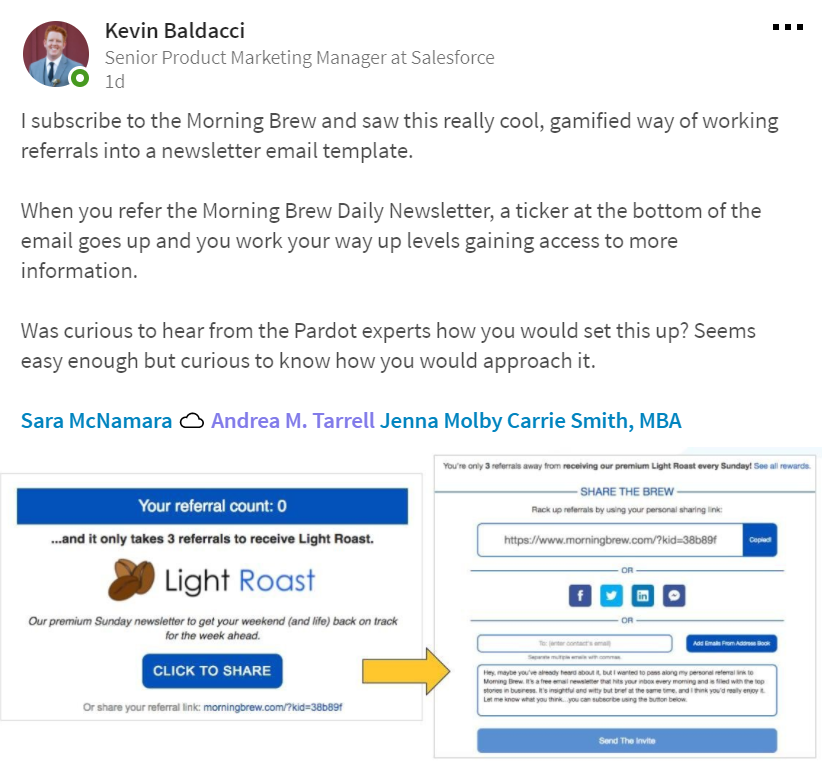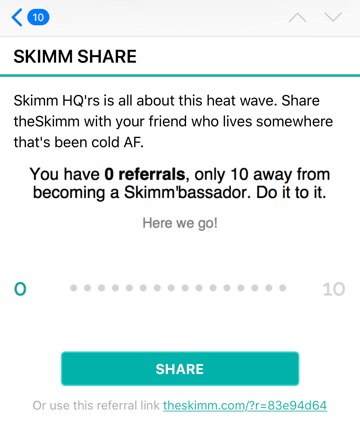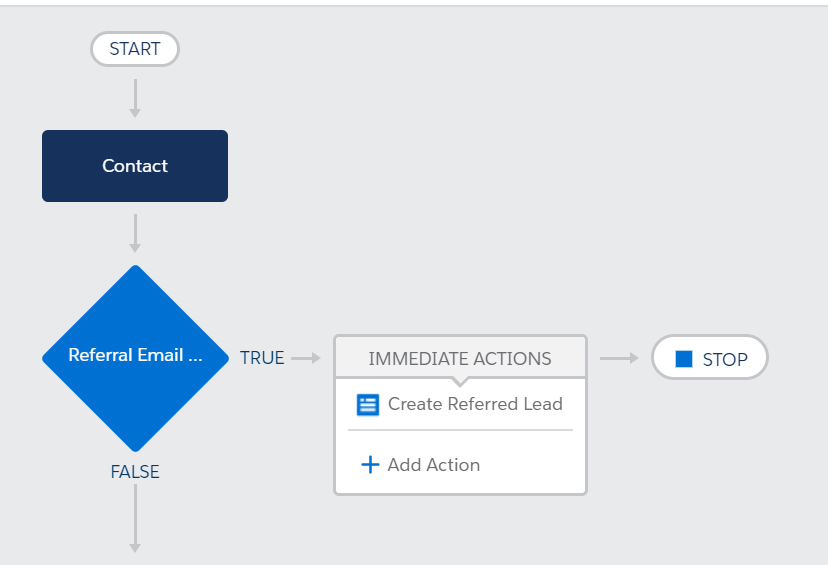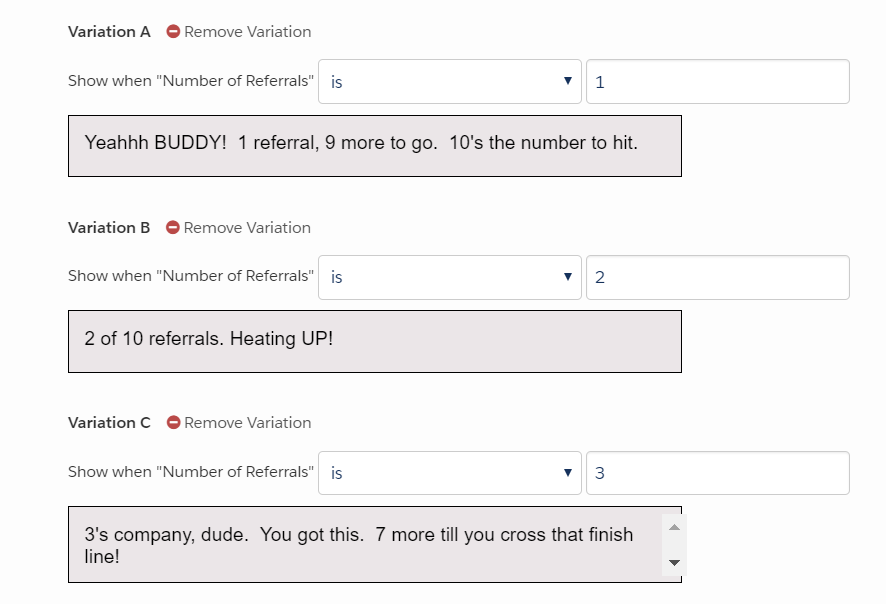I love a good challenge. Especially one about how to leverage Pardot functionality to its fullest potential to level up your marketing.
So when the wonderful Kevin Baldacci from the Pardot Product Marketing team tagged me in a LinkedIn post yesterday, my reaction was “GAME ON!”
Here’s the doozy he came up with:

More about this gamified subscription technique
I think this is a pretty awesomesauce tactic. One of my top email marketing crushes, The Skimm does something similar in their newsletter that I admire in my inbox on the daily:

But does it work though? The Skimm has grown its subscription audience to 1 million in less than 3 years, and has over 2K people who have completed 10 shares to earn “Skimmbassador” status.
So I’m going to go out on a limb and say yep, it’s working.
A word of caution: this is kind of a compliance grey area, because you’re technically sending emails to people who haven’t explicitly opted in. I’d say definitely talk to your resident legal guru, and use your referred contacts wisely — invite them to subscribe, don’t start blowing up their inboxes.
How do you do it in Pardot? A little experiment…
I was dying to give this a try, so started messing around with some ideas and got something pretty similar rigged up in Pardot.
Please note, the proof of concept outlined here just counts the number of referrals — not whether someone actually signed up. The Skimm and the Morning Brew have a system to verify whether people actually register (as Sara McNamara mentioned), and if you wanted to take it to that level, you’d probably need custom code or an AppExchange product.
On to the how-to! A detailed step-by-step would be excruciatingly long, so I’m going to give you the highlights reel of how to make this happen in your Pardot org:
Step 1: Create a bunch of custom fields
- Number of Referrals (number)
- Email of the Buddy You Want to Share This With (text)
- Quick Note to Your Buddy on Why You’re Sharing (text)
- Person Who Referred You (text)
- Why Person Referred You (text)
Create these in Pardot, and in Salesforce on both Contacts & Leads.
Step 2: Create your referral form
Mine looked a little like this:
Give it a try! And feel free to enter a real person’s email who would enjoy The Spot for Pardot so I can invite them to check it out.
Your form’s completion actions should be set to include an assign to user step (to ensure it syncs over to Salesforce) and to increment the Number of Referrals field by +1:

If you tested my form… note that when you submit it, there’s a variable tag that’s displaying the recently incremented field value.
Here’s what that looks like in the set up of the thank you content for the form:

Step 3: Get your process builder on
Steps 1 and 2 will get you the data you need in Pardot. But what good is an email address to you hanging out in a custom field? Especially one that can be overwritten by zealous referrers?
Nope, we need a new lead record created. And that means… Process Builder, ladies and gentlemen. You might want to grab a Salesforce admin for this or earn some shiny new Trailhead badges to get ready for this part.
The first step of the Process Builder flow should check if the “Email of the Buddy You Want to Share This With” has been changed. If so, then the “Immediate Action” should be to create a lead record:

Now, we get fancy. We want to move data from fields on the Referrer Contact to DIFFERENT fields on the Referee Lead.
- Email of the Buddy You Want to Share This With goes to the new Lead’s Email field
- Email goes to the new Lead’s Person Who Referred You field
- Quick Note to Your Buddy on Why You’re Sharing goes to the new Lead’s Why Person Referred You field
These Contact fields will be pointed to the Lead using field references, so that the value is basically copied between the fields. It should look something like this:

Activate the process, test, and voila! You got yourself a referred lead.
Step 4: Configure dynamic content blocks to show referrer their progress
Write custom content that you can add to your email footer showing your Referrer what kind of progress they’re making. Maybe something like…

Steps 5+: More things you’d need to make this a viable solution
That’s as far as I took this. It was intended to be a proof of concept and not a full blown solution.
But if you WERE really going to put this into practice. I would say you should also:
- Create a version of this process that kicks off when a Lead submits a referral (mine handles the scenario when a Contact submits a referral, but you probably need both depending on how your Pardot/Salesforce connector is configured.)
- Make sure to map the lead fields to the correct contact fields in Salesforce so you don’t lose data when the lead is converted
- Put duplicate matching rules in place to prevent referred leads from being created with the same email addresses
- Add the referrer and referree to campaigns so that you can track marketing/sales results and tie back to this event
- Create an Engagement Studio that kicks off a welcome email to the referee explaining why they got on this list and how to opt in or out
- Add a dynamic content module somewhere on your website with some witty copy asking for more referrals. You could set this to show only if # of referrals > 0 or with some other custom logic.
- Consult your resident compliance guru on whether this fits with your existing opt in policy (it definitely would not fly in Canada or Europe)
Other considerations if you want to do your own experiment
If you’re going to play with this, DEFINITELY do this in a Sandbox.
And test extensively before your subscribers ever set eyes on it. What happens if you submit the form rapidly in quick succession? What happens if you fill out the referral form as a non-subscriber? What if you enter a value that’s wacky or too long? What happens if there’s a record sync error, and the prospect is delayed from syncing with Salesforce?
Basically try as hard as you can to break it before you bring it to prime time.
Then have other people try to test and break it. Then maybe try with a small group of subscribers.
What’s your off-the-wall challenge?
I love to whiteboard solutions to complex problems.
Got a thinker on your hands? Lay it on me! Put it in the comments.
Is anyone considering trying the above? Would love to hear how you do it and what your results are.









